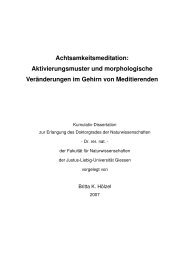the magazine of astounding sound
the magazine of astounding sound
the magazine of astounding sound
Create successful ePaper yourself
Turn your PDF publications into a flip-book with our unique Google optimized e-Paper software.
cartridge<br />
The Grado Signature cartridge installed on <strong>the</strong> tonearm<br />
when I bought <strong>the</strong> turntable had a bent cantilever. My<br />
friend Bernd just happened to have a brand new Benz<br />
MC-2 and since <strong>the</strong> price was right, it went straight<br />
under <strong>the</strong> Grado headshell.<br />
The Benz family <strong>of</strong> cartridges is somewhat <strong>of</strong> an interesting<br />
story. The Benz Company ( from Switzerland) is<br />
a manufacturer <strong>of</strong> high quality cartridges. They design<br />
and manufacture cartridges under thier own name<br />
as well as producing cartridges for o<strong>the</strong>r companies,<br />
which sometimes leads to confusion. My cartridge is<br />
called <strong>the</strong> MC-2 (Europe), however kit is called <strong>the</strong><br />
MC-3 in <strong>the</strong> US, and is identical or very close to <strong>the</strong><br />
Madrigal Carnegie 2, Taurus DDT, Empire MC1000,<br />
van den Hul MC-10, MC-one, MC-two,<br />
Empire MC-2000, and has lots <strong>of</strong> similarities<br />
with some Ort<strong>of</strong>on units. This is not to<br />
say a bad word about Benz & Co., but ra<strong>the</strong>r<br />
to take some <strong>of</strong> <strong>the</strong> hype out <strong>of</strong> cartridges.<br />
The same goes for Scan-Tech <strong>of</strong> Japan, who<br />
also make a whole range cartridges under<br />
different names.<br />
Anyway, my Benz MC-2 worked great for a<br />
year or so but <strong>the</strong>n <strong>the</strong> <strong>sound</strong> slowly began<br />
to degrade. At first I thought I had some bad<br />
records, but I began to notice how <strong>the</strong> strong<br />
bass and clear highs were dissappearing,<br />
and <strong>the</strong> <strong>sound</strong>stage width and depth began<br />
to dissappear. After some troubleshooting<br />
we tracked <strong>the</strong> problem down to <strong>the</strong> cartridge.<br />
It became so bad that I had to send<br />
<strong>the</strong> cartridge back to <strong>the</strong> factory. It turned<br />
out to be a suspension related problem.<br />
What happened was <strong>the</strong> little ”rubber” suspension<br />
ring had dried out and become hard<br />
so that it limited <strong>the</strong> cantilever free travel. I<br />
later heard that this happened to o<strong>the</strong>r cartridges<br />
too. The factory replaced <strong>the</strong><br />
“rubber”ring with one <strong>of</strong> some o<strong>the</strong>r material<br />
and all work fine now.<br />
For me this cartridge is a typical MC cartridge<br />
- deepbass, laid back midrange and<br />
good highs with a lot <strong>of</strong> detail. I used 2.1<br />
grams tracking force and 24 degrees VTA<br />
(rear <strong>of</strong> cartridge/tonearm slightly down).<br />
<strong>the</strong> factory recommends a tracking force <strong>of</strong><br />
1.8 grams, but I didn’t like it so much, it<br />
was somewhat thin <strong>sound</strong>ing. The channel separation<br />
is given as 28dB and it puts out 0.3 mV which means<br />
that an excellent phono stage is a must.<br />
While my cartridge was at <strong>the</strong> factory I still wanted to<br />
play records, so I checked out my friend Bernd’s collection<br />
to see what he had that I might like. As it happened<br />
a Koetsu Black Magic Gold had just arrived from<br />
van den Hul where it was serviced and retipped. I purchased<br />
it on <strong>the</strong> spot and it really made me happy, in<br />
fact I still use it today. There is something special about<br />
Koetsus. I heard a Koetsu Rosewood on Bernd’s<br />
Goldmund turntable, so I know what I’m talking<br />
about). The Koetsu organizes <strong>the</strong> <strong>sound</strong> and puts everything<br />
in <strong>the</strong> middle where it belongs, but with a<br />
wide and deep <strong>sound</strong>stage. (“Honey” is <strong>the</strong> term my<br />
Aussie buds use to describe <strong>the</strong> K. <strong>sound</strong> - I’m in love<br />
with my own Koetsu Black as well - B.)<br />
The Koetsu is very sensitive to all parameters. After<br />
much trying and experimenting I ended up with a VTA<br />
<strong>of</strong> 25 degrees, tracking force <strong>of</strong> 2.0 grams, 47Kohm<br />
loading and a 100 pF cap. The difference between 1.8<br />
grm and 2.0 gram tracking is very audible. It’s fun to<br />
experiment with this Koetsu because when everything<br />
is right it really sings.<br />
tonearm<br />
All this experimenting led to modification <strong>of</strong> <strong>the</strong> Grado<br />
tonearm.<br />
It’s Grado’s approach to not use only gravity or only<br />
spring force to adjust tracking force, but ra<strong>the</strong>r both.<br />
For 1-1/2 grams <strong>of</strong> tracking force, <strong>the</strong> setup uses 1<br />
gram <strong>of</strong> gravitational load and 1/2 gram <strong>of</strong> spring<br />
load. With a combination <strong>of</strong> a built-in spring and several<br />
weights this is a relatively easy adjustment to<br />
achieve on a Grado tonearm. Once <strong>the</strong> tonarm is set<br />
up it is a great tracker, but some recent developments<br />
made me curious.<br />
Some friends in <strong>the</strong> German audio community believe<br />
that a tonearm should have no damping at all, but<br />
ra<strong>the</strong>r should move as freely as possible in order to get<br />
that last little bit <strong>of</strong> air. One friend uses a Grado tonearm<br />
in which he took <strong>the</strong> damping completely out -<br />
no spring load, just <strong>the</strong> counterweight load, and he<br />
reports good results.<br />
The Grado tonearm has one big counterweight and two<br />
small ones, so called micro-weights, for setting <strong>the</strong><br />
gravity to spring force ratio. This brought up an idea -<br />
what if I take out <strong>the</strong> spring load, construct one weight<br />
which is lower, actually below <strong>the</strong> cartridge, and take<br />
<strong>the</strong> little weights <strong>of</strong>f <strong>the</strong> tonearm? The idea was that<br />
by constructing a new weight I could lower <strong>the</strong> center<br />
<strong>of</strong> <strong>the</strong> counterweight compared to <strong>the</strong> turnaxis (center<br />
<strong>of</strong> gravity) and move <strong>the</strong> weight closer to <strong>the</strong> vertical<br />
axis. This would give a more stable tonearm with<br />
respect to up and down movement (faster standstill)<br />
so it would play slightly warped records more easily.<br />
See drawing three for inspiration.<br />
I constructed a new counterweight which is solid<br />
aluminumand steel by measuring <strong>the</strong> original weights<br />
and trying to get as close as possible. Of course <strong>the</strong><br />
first attempt ended up way too heavy, so I had to machine<br />
<strong>the</strong> sides a little more until it worked. Adjusting<br />
<strong>the</strong> tracking force is a little difficult now - if you move<br />
<strong>the</strong> weight a little too far you’re immediately <strong>of</strong>f 10-<br />
15 grams! I didn’t change anything on <strong>the</strong> tonearm, so<br />
I could always go back to <strong>the</strong> factory setup<br />
But it was worth <strong>the</strong> trouble. The <strong>sound</strong> is<br />
very airy now. Remember <strong>the</strong> tracking force<br />
is still 2.0 grams, but <strong>the</strong> damping, o<strong>the</strong>r<br />
than <strong>the</strong> friction in <strong>the</strong> bearings, is gone. I<br />
like it better <strong>the</strong> way it is now, but some<br />
reader will disagree and use a spoon wading<br />
through a basin <strong>of</strong> silicone oil!<br />
Shortly after I completed <strong>the</strong> experiment<br />
with <strong>the</strong> counterweight I spotted an article<br />
about a Roksan tonearm upgrade called <strong>the</strong><br />
Tabriz Tonearm with 2i counterweight. On<br />
<strong>the</strong> Roksan Artemiz counterweight this idea<br />
has been taken to <strong>the</strong> limit, <strong>the</strong> weight rests<br />
only on a spike so it can swing freely without<br />
moving forward or backward and altering<br />
<strong>the</strong> tracking force. This works great<br />
and I’m a little surprised not to see more<br />
manufacturers picking up <strong>the</strong> idea. It’s<br />
probably a matter <strong>of</strong> taste.<br />
Right now I use all <strong>the</strong> above mods with great<br />
satisfaction. I use <strong>the</strong> Welborne Labs Phono-<br />
1 kit in connection with a German made<br />
pre-preamp. I have about 63 dB gain<br />
(Phono-1, 36dB, pre-pre, 27 dB) which is a<br />
lot, but <strong>the</strong>n again quite a lot <strong>of</strong> cartridges<br />
put out something in <strong>the</strong> neighborhood <strong>of</strong><br />
0.3 mV, so this is about what is needed.<br />
The loading is 47kohms. I tried 100K, 30K,<br />
10K, and even no loading in <strong>the</strong> past, but I<br />
go back to 47Kohms every time. The capacitive<br />
loading is 100 pF. My system consists <strong>of</strong> a switching<br />
unit with stepped attenuator, two Welborne Laurel<br />
monoblocks with Cetron 300Bs and a full range<br />
Edgarhorn system (see October 97 VALVE). I found it<br />
unecesssary to use a preamp because all components<br />
put out more than 2 volts, enough to drive <strong>the</strong> laurels/Edgarhorns<br />
to disco level. However, I installed a<br />
buffer to compensate for <strong>the</strong> 20 ft. Kimber interconnects.<br />
Maybe Ron Welborne was right when he mentioned<br />
in his catalog “This is <strong>the</strong> last phono amp you will ever<br />
need”. Maybe that and a pair <strong>of</strong> triode amps and good<br />
horns is all we really need.







